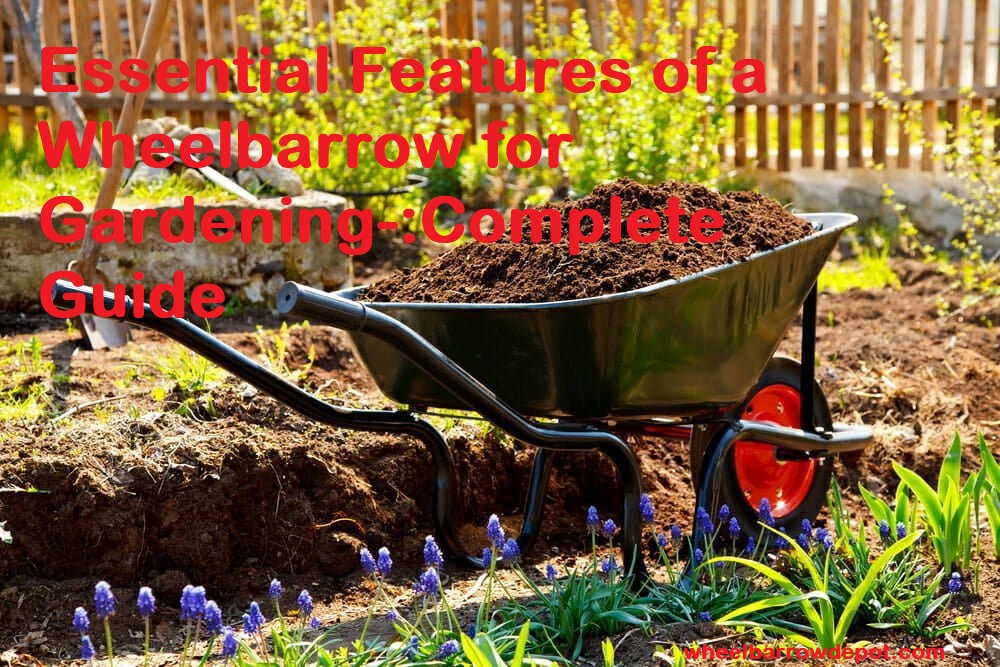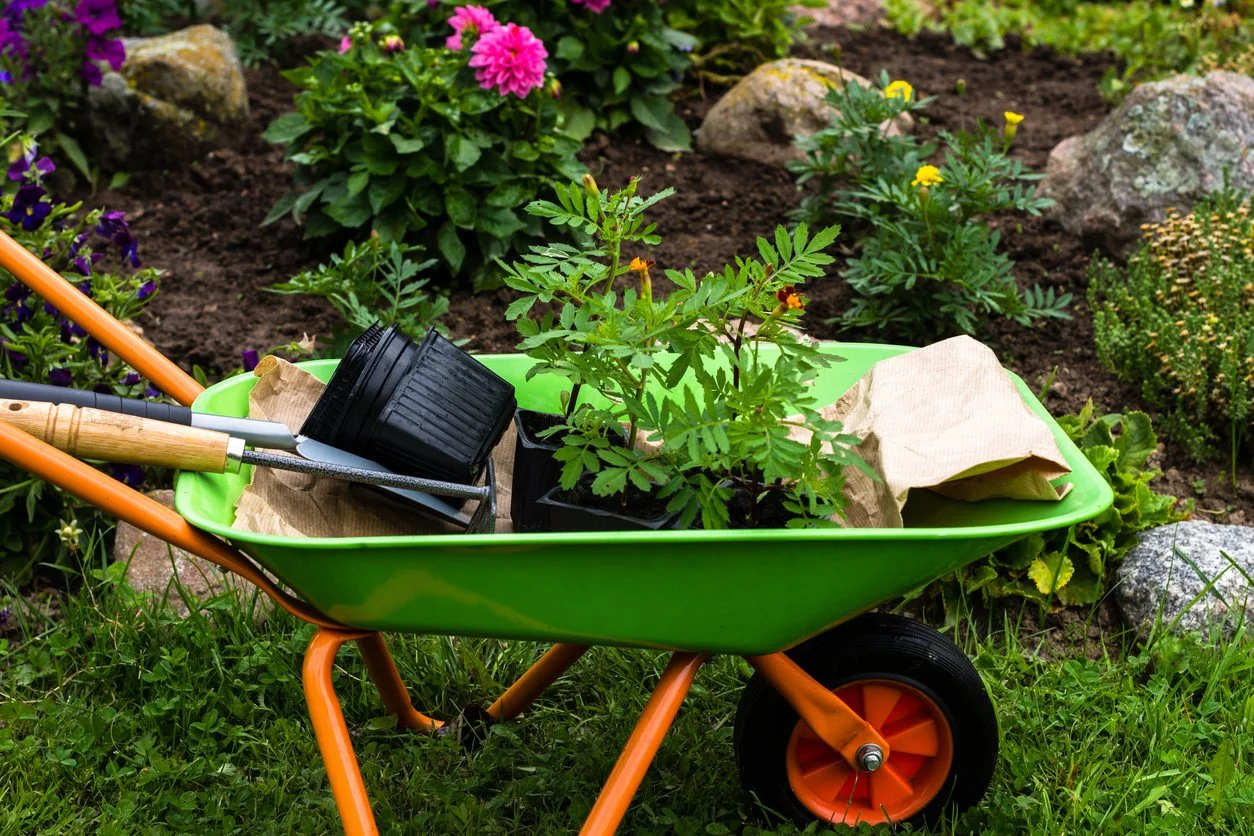Are you looking for the perfect wheelbarrow for your gardening needs? You’ve come to the right place!
This guide outlines all the essential features of a wheelbarrow so you can make an informed decision and choose the best tool for your gardening tasks.
A wheelbarrow is an essential tool for many of us gardening enthusiasts. It provides us with a versatile and easy way to transport plants, soil, and other materials from one area of our garden to another. But not all wheelbarrows are created equal – in fact, there are many important features that should be considered when selecting a wheelbarrow for your gardening needs. In this complete guide, we will explain the most essential features of a wheelbarrow for gardening and help you choose the right one for your purposes.
We will start by discussing the advantages of having a wheelbarrow in your garden and then move on to discuss some of the key features to look for when selecting one that best suits your needs. We will explain why certain materials are better suited than others, what size and weight capacity means, as well as additional concerns like ergonomics. Finally, we’ll wrap up with our top picks for best wheelbarrows according to material quality, weight capacity, size and affordability.

Material and Durability
It is important to consider the materials of a wheelbarrow. Wheelbarrows come in a variety of materials, each with its own advantages and drawbacks.
Steel – The advantage with steel wheelbarrows is that they tend to be stronger and more durable compared to those made from other materials. They’re weatherproof, so you can use them in any season without fear of rusting or damage from rain or snow. However, one negative is that they’re heavier than their plastic counterparts and may require more effort when moving objects in them.
Plastic – Plastic wheelbarrows are lighter than their steel counterparts and cost less as well. They don’t rust like steel and can be cleaned quite easily since they resist dirt accumulation better than other materials due to having no pores on their surface. At the same time, they’re not as durable as a steel ones and can break or crack if overloaded or mishandled.
Overview of the different materials that wheelbarrows are made of
Wheelbarrows are essential for many gardening tasks, and come in a wide range of sizes, shapes, and materials. When selecting the right model for your garden, it is important to consider the characteristics of the various materials used to make wheelbarrows. Different materials will require more maintenance or be more suited to specific tasks. The following is an overview of the most common materials used in wheelbarrow construction:
Wood – This classic material make a great selection when looking for a decorative option or one with a light load-bearing capacity; however, it can deteriorate quickly in wet weather.
Aluminum – Sturdy and lightweight, aluminum is an ideal choice when looking for a load-bearing capacity on the lighter side or need fast-moving containers. It has excellent rust resistance but can get scratched or dented over time if not adequately protected from tough use.
Steel – Strongest among metals used to make wheelbarrows, steel offers good rust protection particularly when zinc coated during production and carries heavy loads well; however, strong winds may cause its large surface area to be pushed around as it is heavier than other metals.
Plastic – Inexpensive and lightweight yet equally as sturdy as metal options when adequately constructed, plastic has become increasing popular because it does not rust like metals do and thus requires minimal maintenance. However due to its thin inner walls it may be unsuitable for heavy duty tasks such as stone transport without deforming in place over time.
Importance of selecting a durable material for your wheelbarrow
A garden wheelbarrow is an essential gardening tool because it helps you to transport materials and tools conveniently around your garden. In order to ensure that the wheelbarrow serves its purpose well, it is important to choose a durable material for its construction. The most common materials used for making wheelbarrows are metal, wood and plastic.
Metal wheelbarrows are often expensive and may not be suitable if you need a low-cost option or if the weight of the material being transported is considerable. However, such wheelbarows are usually strong and long lasting, so if you need something that will last for years then metal may be a good option.
Wooden wheelbarrows tend to be less expensive than those made of metal and may be more aesthetically pleasing in some gardens. They are not suitable for large gardens as they are generally heavier than metal or plastic choices. Wood requires more maintenance than other materials but can resist rot better than other kinds of material when treated properly with oil or paint.
Plastic wheelbarrows are generally considered the best choice after metal because they serve all the purposes that wooden or metal wheels provide but can be got at lower prices with optimum convenience of use, transportation and storage. Plastic also provides greater resistance to rust and other forms of deterioration ensuring that the product remains in good shape over time even with regular use in harsh conditions common in some gardens.
Factors to consider when selecting a durable material
When you are selecting materials for a wheelbarrow, you need to consider durability, comfort, weight capacity and cost. Durable materials will ensure that your wheelbarrow is able to endure regular use while providing a safe experience so that you can maintain your gardening duties throughout the season. Here are some of the most common options available when it comes to finding an appropriate wheelbarrow material:
Steel: Steel is a strong and hefty material which provides plenty of long-term durability and sturdiness. Of course, this extra stability doesn’t come without its own disadvantages as steel wheelbarrows tend to be heavier and more expensive compared to their plastic alternatives.
Plastic: Plastic wheelbarrows are usually much lighter in comparison with steel models and may be slightly cheaper too. Plastic however lacks the same level of rigidity as steel due to its lighter weight but still provides durable performance when cared for properly.
Wood & Metal Frame: A metal or wooden frame provides adequate support while reducing overall weight but be sure to select treated wood or rust-resistant metals like aluminum or stainless steel if these are options available in your locale. This should help prevent any issues with moisture or breakdowns caused by regular exposure to air, soil and fertilizers in the garden environment.
III. Handles and Grips
The handles and grips of the wheelbarrow are key features in transporting soil, fertilizer, and plants. For added comfort, look for a model that has wider grips made of soft foam or rubber. These materials will help to provide an ergonomic handle that reduces strain on the hands from shock and vibration when hauling large loads.
The handles should also have a rugged construction with reinforcement to absorb impact and stress when maneuvering the barrow. Additionally, it’s best to consider models with dual handles that provide more stability while transporting loads over rough ground and maneuvering around curves.
Importance of having comfortable and sturdy handles and grips
The handles of your wheelbarrow are very important; they need to be comfortable and sturdy in order for you to maneuver it. Not paying close attention to the wheels, handles, and a frame when you buy a wheelbarrow, can leave you with an uncomfortable, unbalanced wheelbarrow that will cause you a great deal of difficulty when trying to move heavy loads.
Wheelbarrows usually have two handles – one on each side of the body, with each mounted on a level plane. The proper positioning of the handles will depend on how they are going to be used: If the wheelbarrow is likely to be carried with relatively light loads, consider getting one with handles closer together. On the other hand, if it is mainly used for digging and moving heavy loads over rough terrain or uphill slopes then put some thought into selecting one with properly positioned wide apart and extended handles.
Sturdy grips are just as important as comfortable ones. Many wheelbarrows come equipped with padded ergonomic foam grips which allow for a better grip because of their non-slip quality. In addition, these types of grips also work well to absorb shock from uneven surfaces providing increased comfort when using your wheelbarrow. A standard steel handle will also do the job without padded grips if preferred, however make sure that it is firmly secured in place before using your wheelbarrow to avoid accidental slipping or detachment from regular use over time.

Factors to consider when selecting handles and grips
When selecting a handle or grip for your wheelbarrow, it is important to consider the material and design of the handles in order to provide an ergonomic experience. Handles with a looped design can help you get a better grip and make it easier to maneuver around corners or through narrow spaces. An overmolded handle can help keep your hands comfortable while pushing and pulling the wheelbarrow by providing cushioning between your hands and the metal handlebar. Handles made out of lighter materials such as aluminum alloy are also beneficial because they won’t add too much weight to the wheelbarrow.
When deciding on the length of your handles, keep in mind that having too short of a handle can make it difficult to control the wind barrow, while having too long of a handle will cause you to lean forward and possibly strain your back muscles. For optimal control, try looking for handles that have adjustable-length options so that you can find one that is most comfortable for you.
Stability and Balance
Stability and balance are an essential factor to consider when purchasing a wheelbarrow for gardening. A wheelbarrow with a wide wheelbase provides more stability and will ensure you don’t tip over while carrying it. Depending on the terrain, you may prefer a wheel that is larger and more robust or one that is smaller and more maneuverable.
Consider the size of your load to determine the size of wheel that best suits your needs. Additionally, look for features such as handles that are ergonomically designed to provide optimal leverage and make lifting easier, which improves overall maneuverability.
Importance of having a stable and balanced wheelbarrow
One of the most important features for any wheelbarrow designed for gardening is stability. While this factor is often overlooked, it is essential for having a successful and enjoyable experience. After all, there is nothing worse than carrying an uneven load of soil or mulch, only to have the wheelbarrow tip over and spill the contents.
It’s important to have a wheelbarrow that is well balanced so that when moving with soil, compost or mulch your arms don’t get tired as quickly. Unbalanced wheelbarrows may also make it more difficult to manoeuvre across different types of terrain including slopes and uneven surfaces which you may encounter when working in your garden.
The type and design of wheelbase also play an important role in providing balance and stability. Some wheelbarrows come with a standard design while others come with special wheels that allow the user to maneuver around any type of terrain, including sandy or hilly areas. The size of the wheelbase can influence how easy it is to control the weight distribution, making it easier to move a heavier load without losing your force or tipping over.
Choosing a wheelbarrow that provides adequate support, balance and stability can help reduce strain on your body as you transport gardening supplies around your garden space.
Overview of the different features that contribute to stability and balance
A wheelbarrow is an essential tool for any avid gardener, as it provides a means of transporting tools, plants and soil around a garden easily and efficiently. When selecting a wheelbarrow, there are certain key features to consider that will contribute to the wheelbarrow’s stability and balance when in use.
The size of the wheelbarrow should be considered first – small wheelbarrows with narrower widths are generally more maneuverable than larger ones with wider ones. The size of the wheel also matters; bigger wheels reduce effort during transportation over rough ground, while small wheels make maneuvering around corners easy. The tread pattern on the wheel can also be an important factor – small grooves or tread on the rubber help grip onto surfaces such as grass or dirt while being pushed or pulled, whereas smooth rubber won’t grip as well.
The handle of the wheelbarrow is another important feature to consider as it determines how comfortable it is to use when transporting items. It’s important to look for handles that have a textured surface that won’t slip out of your hands when wet or covered in soil. Some models available come with two handles which provide excellent balance when pushing/pulling indoors and outdoors
Finally, its useful to seek out additional features such as splashguards which prevent compost from spilling out over the sides and adjustable legs which allow for easier storage/transportation by reducing height clearance requirements as well as providing better stability on uneven surfaces such as steps or slopes in a garden. All these features together help create an ideal gardening tool giving stability, balance and ease of use for any avid gardener!
Conclusion
Now that you have reviewed the essential features of a wheelbarrow for gardening, you can make an educated decision when selecting one that best suits your needs. In some cases, adding extra features such as a detachable bucket for compost, foam handles for added comfort or a foot lever for easier lifting can be beneficial.
Consider the size of your garden and distance to be traveled within it when choosing the style and number of wheels. Remember, you will be depending on your wheelbarrow to assist with gardening projects and work efficiently.
Have fun browsing through models and finding the perfect tool that fits all of your criteria!
FAQ’S
What are the features of wheelbarrow?
- A container for holding and transporting items
- One or two wheels for easy maneuverability
- Handles for pushing and steering
- Often made of sturdy materials such as metal or heavy-duty plastic
What should I look for in a wheelbarrow?
- Appropriate size and weight capacity for your needs
- Sturdy construction and materials
- Maneuverability and ease of use
- Comfortable handles for gripping and pushing
- Optional features such as a dumping mechanism or flat-free tires
What is the characteristic and uses of wheelbarrow?
- Characteristics: container for carrying items, one or two wheels, handles for pushing and steering
- Uses: transporting materials such as dirt, rocks, or plants, mixing and pouring concrete, carrying tools and supplies
What is the use of a wheelbarrow in the garden?
- Transporting soil, mulch, or compost
- Moving plants or trees
- Carrying tools and supplies
- Collecting yard waste for disposal
What is the advantage of wheelbarrow?
- Can transport heavy or bulky items with ease
- Maneuvers easily over rough terrain or uneven surfaces
- Can save time and reduce physical strain compared to carrying items by hand
What are some fun facts about wheelbarrows?
- Invented in China over 2,000 years ago
- Originally used for transporting grain and other goods
- Played a significant role in the construction of the Great Wall of China
- Can be used as a makeshift musical instrument by striking the metal container with a stick
What is the description of wheelbarrow in agriculture?
- Used for transporting crops, fertilizer, and other agricultural materials
- Can be pulled by a person or animal, or attached to a tractor for larger-scale operations
What is the working principle of wheelbarrow?
The working principle of a wheelbarrow is based on the principle of the lever, which is used to lift and move heavy objects with less effort.
How do you maintain a wheelbarrow in agriculture?
To maintain a wheelbarrow in agriculture, it is important to keep it clean and free of debris, lubricate the moving parts regularly, keep the tires inflated to the proper pressure, and store it in a dry place when not in use.
How does a wheelbarrow make life easier?
A wheelbarrow makes life easier by allowing people to move heavy objects with less effort and more efficiently. It can save time and reduce the risk of injury or strain on the body. It is also useful in agriculture, construction, and gardening for transporting tools, materials, and plants.
See more-
- Best wheelbarrow for home use 2023
- Best electric wheelbarrow 2023
- Best wheelbarrow for horse manure 2023
- Best ergonomic wheelbarrow 2023
- Best wheelbarrow for landscaping 2023

Richard Tolliver is a seasoned author and the CEO of a popular wheelbarrowdepot and informative website. With a degree in Horticulture from the University of Missouri, he worked as a professional landscaper and garden designer for several years. His website, founded in 2010, offers comprehensive and unbiased reviews of the best wheelbarrows available in the market, helping readers make informed decisions based on their needs and budget. His expertise and knowledge have been recognized by industry professionals, and he continues to inspire gardening enthusiasts and outdoor enthusiasts alike with his personal experiences and tips on creating beautiful and sustainable outdoor spaces.

